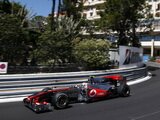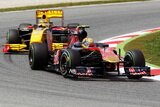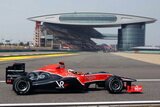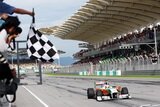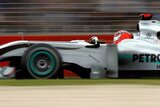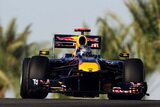Q: Your drivers have seemed easier on the tyres in the first couple of grands prix this year. How did they extract that performance in the first couple of races but not in the next couple?
PW: All the races are different, all the layouts are different and the last circuit maybe suited our car less than the other ones.
Q: That’s the only reason?
PW: I think so, yes.
Q: And when it comes to this race?
PW: I hope it will be OK. We will see tomorrow.
Q: It’s an interesting new partnership with Chelsea Football Club. Does that include more resources. It there a possibility for expansion in terms of resources?
PW: I don’t know. I’m not really the right person to give this answer. I think you will have to ask Peter Sauber for that.
Q: Paul, a different range of tyres this year in terms of specification. How much has the game changed this year in terms of that specification change?
Paul Hembery: Predominantly the compound choices have been a little bit more aggressive. If I take the scaling, the Supersoft tyre stays the same, the Soft tyre this year is derived from the Supersoft, and the Medium tyre this year is actually a close relation in terms of compounding to the Soft tyre of last year. So, there are some similarities to last year but the Hard tyre in particular is very much different. If we think about last year when we were here, the harder tyre in particular created quite a few struggles for the teams to get working. There were probably only two drivers in that race that got it working. So, yes there have been some changes.
Q: We’ve heard a lot about tyre temperature recently - degradation, wear etc. Can you just explain to us, because I think the media need an explanation, about what the difference is and how they affect the cars?
PH: Degradation is a thermal performance loss - that’s from the tyres overheating essentially, taken to extremes in terms of lap time. Wear is the physical wear of the tyre which is probably easier for people to understand. The two are linked, though not necessarily in a parallel manner, but they are linked. The temperature, well, working range is something people hear a lot about. Last year we were finding that the Soft tyre, if we take that as a good example, had a working range from 20 degrees all the way through to the late 30s. This season we’ve seen that when the temperature dropped dramatically in Shanghai that caused quite a dramatic change in tyre performance when it went below 20 degrees. So there’s probably some sensitivity there, and depending on the cars we were looking at we could see that the actual temperature of the tyres was less, so we have to imagine there’s less energy going into the tyre. At the other end because we've taken a more aggressive approach to compounding you’ll find that when it gets to the other extremes of temperature, with abrasion or certainly wheel spin then we will go into an overheating mode. We’ve closed down the range of compounds and the cars have obviously changed as well, and you put that combination together and you have a start to the season pretty much as we saw last year - some question marks that tend to get ironed out as the season goes on and the teams get to understand better the cars, the tyres how to get the best out of them all. I think you’ll see over the next few races that that will be the case.
Q: How concerned are you about the drop in temperature we’re expecting on Sunday? We saw 44 degrees today but apparently it will be at least 10 less on Sunday.
PH: No. As I mentioned it’s more likely when you go below 20 degrees, when it’s cooler. It’ll probably be in Germany or at Silverstone where we’ll get more of an issue with that.
Q: No problem?
PH: No.
Q: Mark, welcome to you here. Maybe we were wrong but we perhaps expected more from Caterham this year. What can be done to improve it? What did you find in Mugello? Has it improved since Mugello?
Mark Smith: It’s perhaps not unreasonable to have expected more us as a team. I think we’re all a little bit disappointed with where we are. We want to perform better. I feel we’ve made progress since last year. You have to look and measure your performance relative to the teams you’re competitive with and I think we have made some progress but it’s clearly not enough, it’s not where we want to be. I think it’s part of being a relatively immature team, even though there are many people in the team with experience. To make the team gel and to provide the tools to actually take the team forward takes a little bit of time. I genuinely think we are on the road to putting those tools in place, whether it’s personnel or hardware or software, that’s what we’re working hard on at the moment. In terms of Mugello, it was useful for further developments that we’re making in the aero world. I think it’s fairly obvious that’s the area we need to make significant improvement in. In terms of what we took there and why it’s not here, in reality we had to commit to something because of the timing of the Mugello test that we hadn't fully developed in CFD or the wind tunnel environment.
Q: What about the performance of the drivers? It’s interesting that Heikki has out-qualified his team-mate four to one, but Vitaly has out-raced his team-mate four to zero.
MS: I think that as a team we’re very happy with both drivers. Vitaly joining the team has been a breath of fresh air for all of us. We’ve got two drivers who are both very motivated and give of their best at all times and at all locations. We’re totally happy with them.
Q: Giorgio, welcome again. I mentioned the other day the pace of development. The factory as a whole has expanded - you have more space for development, more space for people. Is that the case? Is there more development coming from the team now?
Giorgio Ascanelli: It is the case indeed. The straight answer is: Do we get more bits? Yes, we do. Are they good bits? Sometimes.
Q: So what did you learn in Mugello?
GA: Half the things we brought to Mugello worked, half didn’t. We have to keep looking at it. We couldn’t react on the parts that weren’t working for here. I think we’ll have another stab at it Canada because Monaco is no place to do this kind of work.
Q: Interesting that the consistency hasn't always been there. We saw a remarkable performance from Daniel [Ricciardo], who put in his best ever qualifying in Bahrain but it didn’t seem to continue in the race itself.
GA: I would say we have been consistently slow apart from the qualifying in Bahrain, which was really a flower. So, what do you make of it. Not much. First race - since I’m Toro Rosso we’ve always scored points [there]. No matter what. No matter whether we have the previous year’s car or we’ve made out own car, it means we are trying to come prepared to the first race and maybe someone else doesn’t. Second race was a rolling dice. Third race we were extremely happy… No, in China we had a technical problem that we fought for the whole weekend and in Bahrain we were extremely happy with qualifying and not so happy after the race.
Q: Adrian and Sam, interesting to see both your teams today seeming to do a lot more work on the car, seeming to do perhaps more than usual. Was this a continuation today of the Mugello test? Were you still working on test parts?
Adrian Newey: I wouldn’t say this weekend has been any different to the first four races from how we’ve approached the weekend and so forth.
Q: Sam?
Sam Michael: It’s pretty similar for us as well. We’ve had a pretty intensive Friday programme of bringing upgrades and taking lots of measurements throughout P1 and P2 and we had a few bits that we carried over from Mugello to finish off but we would have had a very similar programme whether we went to Mugello or not. All the teams are geared up to not have testing, to not having test teams and that means we’re equipped and do our planning to do all of that work on Friday. So, it wasn’t any different for us here.
Q: How important to both of you was that Mugello test? For instance, Sam, your race drivers didn’t take part in it, whereas Adrian, your race drivers did. How important was it?
SM: From our point of view it was interesting because we used it to get correlation. All of our testing is to do with correlation now. It’s not to dial in the last little bit of the setup. And by running our two test drivers there we get a straight back-to-back with the guys that do the majority of the running in our simulator. So, that’s quite important for us to verify all of our models. I think the test itself, personally, I think you could do without it. I think it’s a lot of energy and expense during the season that we probably don’t need. Of course McLaren will gain a lot out of that test but Formula One is all relative, so all we really did was spend a load of money. And did we really shift relative to Red Bull or Ferrari or Mercedes and the people who we’re competing against? I don’t think so.
Q: Adrian, do you feel the same way?
AN: I think we learnt the pasta in Italy is still the best in the world and that’s about it really. I’d agree with what Sam says. To me, yes you go to the test because it’s available. We didn’t learn anything… relatively speaking. I think Sam’s point is valid. We all spent money but the value of in-season testing has to be questionable.
Q: Adrian, in terms of driver performance this year, how much has changed do you think? Do you think anything has changed between Sebastian Vettel and Mark Webber in the first four grands prix of this year?
AN: No, obviously Sebastian’s confidence is high and Mark is very talented and keeps working so I think y’know, generally Sebastian’s had slightly better results but it’s been close and I’m very happy with both of them.
Q: Sam, it’s a little bit of a mystery that when you were at Williams you were technical director there and now you’re sporting director - could you explain how your duties have changed?
SM: Sure. I work for the senior management group, which means that I work with all the engineering and technical directors at McLaren. My main responsibility is the race track and the drivers but I work within that group in the factory to make McLaren a faster car and a better place.
Q: Very often the sporting director is seen almost as a team manager.
SM: I think if you look in different teams, everyone has different titles, it doesn’t really mean… it doesn’t necessarily related to what they do within that team.
QUESTIONS FROM THE FLOOR
Q: (Ian Parkes - PA) Question to Sam and Adrian. So many times since in-season testing was banned we’ve heard teams and drivers bemoan the fact there is no in-season testing, that they can’t test things, they can’t improve the car etc. So why are you two guys now bemoaning the fact that we’ve just had an in-season test and you learnt nothing from it? Sure that was the whole point of having an in-season test, that you do learn things from it and you move forward.
AN: Neither of us is saying that we haven’t learnt anything from it, it’s just, has it brought anything in particular of real value? And obviously because Formula One is a relative sport and in particular relative to your competition and, as Sam said, since those comments were made we’ve had three years, or whatever it is, of no in-season testing. We’ve all learnt how to use Fridays more effectively as test sessions, so the value of in-season testing has depleted because of that.
SM: same comments
Q: (Daniel Ortelli - AFP) Now that you’ve answered that question, do you think that in-season testing would be more useful later in the season?
AN: I guess if you wanted to use it as research for the following year’s car, possibly. But I think the fact is Formula One budget-wise is… things are tight for a lot of teams and the most expensive thing to do is run the car. That’s far more expensive than wind tunnel testing or CFD or simulators and whatever else you might like to name. If one of the major things is to save costs then I think in-season testing would be one of the relatively low-hanging fruit.
Q: Anyone else have any further comment on that, Giorgio?
GA: Well, things are extremely profitable when they are the same all the time. A team evolves itself to adapt to the conditions of operation which are offered. If you change something you need a different operation. I think that’s what these two gentlemen have tried to say. They are both structured team with a lot of infrastructure. For us it’s a blessing to be able to drive - because we don’t have the infrastructure. Although I agree with AdriAN: the most expensive way to make experience it going around a circuit. If you don’t, and you have a simulator and a good tunnel you make a good profit. If you haven’t got a simulator and haven’t got a good tunnel then you need some running to certify what you do.
Q: Mark, anything to add?
MS: Nothing particularly different to add.
Q: Pierre?
PW: Nothing to add, no.
Q: Paul, did it make a big difference as far as you were concerned or just expense?
PH: Just expense I guess. But, y’know, we have to follow what the desires of the teams are. I think if we were to get any use, it would be to go to one of the tracks where we actually run a Formula One race, [that] would have been more useful to us.
Q: (Mike Doodson - Honorary) Giorgio, you have worked with some of the true greats of our sport, you’re now with a smaller team. I wonder if you would tell us if you see any signs of potential greatness in your drivers and specifically, can you tell us about the moments in the season so far when you’ve been most impressed by each of the two drivers?
GA: I think I already said that I think the qualifying in Bahrain from Daniel has been quite extraordinary. It wasn’t just one lap, the last lap, it was the whole of Q1 - all runs in Q1, in Q2 and Q3 were extremely good. It was sort of what I’ve already said about Sebastian Vettel when he set the famous lap - which I’ve quoted many times - in Valencia when he was running on full tanks and on used tyres and the lap time was, to my eyes, quite exceptional. I think that Sebastian made a big step that day when he noticed that and he thought about it and he could repeat it. Unfortunately we cannot repeat it yet because the race was another story. It’s down to the drivers to find the answers in themselves and in us to help them finding answers. I would say that Daniel has done something that is quite extraordinary. Jev (Jean-Eric Vergne) has a big heart, he is one of the best fuel controllers that I have seen in my life but this is only his fifth event and I think we have to wait a little bit.
Q: (Gary Meenaghan - The National) This year, we have three teams registered to ASNs from outside of Europe: India, Malaysia and Russia. I’m just wondering if any of you guys can a point at any time in the future when a team can actually be based outside of Europe, working from outside of Europe. I know there were some rumours about Abu Dhabi in the past with Toro Rosso and you’ve obviously got Malaysia with Caterham as well.
SM: I think it’s possible but whether it can be competitive will depend on… Strong Formula One teams are made up of good people; whether they can attract enough good people, that will be the critical thing. It’s definitely possible from a manufacturing point of view and setting up equipment and designer, test facilities. That can be done anywhere within reason, but you need, to be competitive in Formula One, you have to attract good people, it’s whether they could cross that boundary.
Q: (Ian Parkes - PA) Paul, Michael Schumacher, as I’m sure you’re aware, was particularly critical of Pirelli post-Bahrain. I just wondered if, as far as you know, he’s a lone voice in the wilderness, first of all? What did you make of his comments? Secondly, he mentioned yesterday that he held a meeting with Pirelli in Mugello. I just wondered if he came away from that with a better understanding of what you guys are trying to achieve this season?
PH: Yeah, he had a meeting with some of our engineers - to be honest, it was a little bit more general than just talking about Bahrain, it was trying to understand what we’re doing with testing, future development, the way we’re going forward and maybe hearing from ourselves of some of the constraints we have. Michael’s obviously a great champion, he’s been the most successful Formula One driver so of course we listen to the comments, but we also have lots of comments from other drivers and until they all say the same thing… We were given an input when we started our adventure in Formula One and we’re still following that, so while we obviously respect it, it’s one of a number and we carry on doing our work.
Q: (Daniel Ortelli - AFP) Question for McLaren: there were a lot of comments about the nose of the car at the beginning of the season. Now you’ve changed it. How much of a marketing tool was it and how much of a technical advantage can it be now?
SM: The change that we’ve made here for this weekend is part of the normal development of the car. Obviously we haven’t changed our chassis and we wouldn’t plan to do that during the season but you’re always exploring things like that, whether it’s the nose, bodywork or wings, all over the car, regardless of what other teams are doing. It’s definitely not a marketing tool. The only reason why we change the car is to improve the aerodynamic efficiency. Here we do have a new nose to evaluate but I would not call it a first order or barely even a second order factor in car performance.
Q: (Kate Walker - Girl Racer) A question on the young driver test; you have the option of Silverstone or Abu Dhabi. There seems to have been some criticism of late about the plans to run in Silverstone, so I was wondering if the five team figures could let me know how they feel about Silverstone, and separately, Paul, for Pirelli, you’re going to have two costs now. How do you feel about that?
PH: I think it’s probably easier for me to start. To be honest, officially, we’ve only had indications from the teams testing in Abu Dhabi. Formally, we haven’t had any indication about Silverstone yet, although verbally we did have a conversation, so we would be keen to know if Silverstone is going to happen or not.
GA: We have budgeted our resources to support 15 days of testing and we were counting on the fact that eventually the young driver test would occur at the end of the year, so that we could sustain it with the engine mileage which was left over from the races, so a second test in the middle of the season which wasn’t planned, for us, is half a million? We don’t have it.
AN: To be honest, I think, if you go back to the essence of what the test is meant to be for, which is to develop young drivers, it’s down to: are you best off evaluating prospective new young drivers in the middle of the season or at the end of the season. Personally, I would have thought at the end of the season because they’re not at a junior formula they’ve been competing in, they’ve finished their championship, you can see how they’ve gone, they’ve got a bit more experience. To drop them into a Formula One car in the middle of the season and then hoof them out again and tell them to wait until another eight months before you drive it again - I’m not sure of the value of that.
SM: I’ve got exactly the same view as Giorgio and Adrian. Our plan at McLaren at the moment is to test in Abu Dhabi. We’re not testing at Silverstone for all those reasons. Engines is a significant factor, as Giorgio said. If you want to test at the end of the year, you have so many part-mileage engines with the race team that all have a little bit of mileage on them so you can effectively do it for free, in terms of your race engines. If you try and do that in the middle of the year, you can’t use your race engines so you have to prepare a special test engine. And also the point that Adrian made is very important, I think, because if you try and have it in the middle of the year, and run your young drivers, then you are running them in the middle of their championship year so you to be at the end, so that they have finished their Formula Three or Formula Two or whatever they’re doing and they have the capacity to concentrate on their Formula One test.
PW: For us it’s quite different. The better compromise in terms of cost would be to test at Silverstone for plenty of reasons: for logistics and costs. It would be better to test at Silverstone.
MS: It’s the same for us: logistically and cost-wise, Silverstone sits better for us.
Q: (Miran Alisic- RTV Slovenia) I have a question for the gentlemen in the front row; you’ve already been in Formula One for a long time. How would you compare or judge or comment on the role and significance of the tyres over three periods, maybe the tyre war, the Bridgestone control tyre and now in the Pirelli era tyre?
SM: The tyres have always been very sensitive, the racing tyres. At the moment, you have an extremely close grid because of the technical regulations and if you look now at the spread from the top 15 teams (drivers) is sometimes this year only one second, so if you have a small variation in your tyre grip, where normally if you have a five or six tenths advantage on the next team, it wouldn’t normally change your position by one or two places, normally you will drop ten positions if you fall out of that window. But there’s been plenty of years previously where we’ve had extremely sensitive tyres to temperature or anything else so I think they are sensitive, but it’s really magnified at the moment because of the closeness of the grid. You pay the penalty very badly if you fall out of that window.
AN: I agree with that. The grid is very tight. The tyres are clearly different to use compared to the Michelins and Bridgestones, just different, not to say better or worse, it’s different, a fresh set of challenges which is good in many ways, I think. If you compare them to let’s say the height of the tyre war between Michelin and Bridgestone, then you got to the point where the race was really a series of qualifying laps and the drivers would therefore push very hard, through the race without worrying too much about degradation, be it thermal or wear. That’s different now. I think that brings a different set of skills to the floor, it’s almost a bit like Prost in the eighties, when he got the reputation for being The Professor, thinking about how he did the race, and I think that’s coming back which I think gives some variety, it gives some change in the field both race-to-race, during the race, qualifying to race. I think that’s all good for the sport, good for spectating.
GA: The car is stuck to the ground because of four contact points and they are the tyres and I would say that after drivers, tyres have always been the most important element of competition, so it doesn’t matter very much if there is competition between tyre manufacturers or not. You’ve got to know them, you’ve got to try to understand them. I think that what has changed over these twenty years - nearly thirty now - is the understanding and of modelling which is available to us, which in reality wasn’t available to us thirty years ago when we had to rely on the feeling of the driver which is still important. There is so much the driver can feel. The nurturing of the grip level, the two temperatures that Paul was describing, how you find them and how you cultivate that, how you keep the tyres into it, is probably still one of the arts of a champion and I don’t think it’s pretty much in our hands.
Q: (Vanessa Ruiz - ESPN Radio) Paul, do you see Pirelli changing its approach to the compounds to the point of them playing as big a role as they do now? I mean lowering the degradation levels, really lowering them, and to the teams, because we heard a few drivers talking about it: would that be something that you want?
PH: We work on the input from the teams, so if the teams want us to take a different approach we can go back to an approach which is probably more akin to what you’d be doing in a tyre competition. As Adrian just mentioned, you could push harder with very minimal degradation. You then started getting into areas of tyre integrity because you start pushing the boundaries of performance of the tyre but it depends on what the challenge is. We’ll do whatever the sport wants us to do and at the moment, I think if you’re looking from the outside, at the start of the season of course the tyres are very important, but as I mentioned earlier on, that’s the teams getting used to what would be for them, maybe changes to the car, slightly different change from ourselves in terms of challenge. As the season progresses you will see that they will master that. They are very good, all these gentlemen around here, very very competent and very amazing teams of engineers working for them. If I took the first winter testing when we came back into the sport, you would have thought we would be doing 25 tyre changes for a race. On the same tyre at the end of the season, they were getting probably 25 to thirty laps out of the same tyre. Things change and the importance for everybody is that they have the same challenge. The engineers and the teams will find their solutions, and as the gentlemen have said, the drivers can also provide some solutions to that.
AN: I think first and foremost, the reason that we’re here is because people are watching it on television so for the good of the sport, it should not actually be our choice, it should be what do people enjoy watching?
MS: I think that’s a perfectly reasonable approach. In any case, I think a team only has so much energy to bring to bear on the task at hand and for us, as a small team, we’ve got bigger fish to fry than to try and influence the tyres. We’re perfectly happy with what we have. It’s a challenge and one that occupies us.
SM: From that point of view, I think the racing’s been very good. It makes our job extremely difficult but that’s what we’re here for, isn’t it? As long as you have the consistency of being able to put on a tyre that’s the same every time, which from our experience with Pirelli it is like that, so then you’re just limited by your ability to understand the tyre, then it’s how good a technical job you do with it. And you can’t really argue that it hasn’t made the racing very good this year. We’re happy with it.
Comments:


